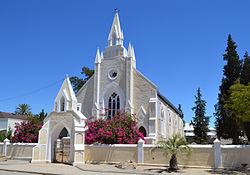Clanwilliam
| Clanwilliam | ||
|---|---|---|
|
|
||
| Coordinates | 32 ° 10 ′ S , 18 ° 52 ′ E | |
| Basic data | ||
| Country | South Africa | |
| Western cape | ||
| District | West coast | |
| ISO 3166-2 | ZA toilet | |
| local community | Cederberg | |
| Residents | 7674 (2011) | |
|
Dutch Reformed Church in Clanwilliam
|
||
Clanwilliam is a town in the municipality of Cederberg , West Coast District , Western Cape Province in South Africa . In 2011 it had 7,674 inhabitants. It is located about 230 kilometers north of Cape Town . The city is one of the oldest cities in South Africa and lies at the foot of the Zederberg (Cederberg) and on the bank of the Olifant , which is dammed here. Not far from Clanwilliam, the Soom schist is one of the most important fossil sites of the Ordovician .
Clanwilliam is the center of the growing region of rooibos - tea . In addition, Clanwilliam is known for its extraordinary flowers in spring.
Attractions
dam
The water supply to the downstream areas served by the Bulshoek Dam (15 miles below Clanwilliam) was inadequate in the early 20th century. Thereupon 1932-1935 three kilometers outside of Clanwilliam a new dam was built in the Olifants to ensure the supply. In the first construction stage it was 38 meters high (above normal river water level) with a capacity of around 74,000,000 m³ and an area of 786 hectares. The catchment area of 2,090 km² includes the rainy mountain region south of Ceres and provides an annual outflow of about 456,000,000 m³, the reservoir overflowed every winter. In order to increase the security of the water supply, the dam crest was increased by six meters from 1964 to 1968. The new capacity is approximately 121,000,000 m³.
In addition to the water supply, the reservoir serves a variety of leisure activities such as the Clanwilliam Triathlon in September / October every year.
Archaeological finds
The numerous rock paintings of the ancestors of the San , which were found in the entire cedar mountains of the northern Western Cape , are of archaeological interest .
In the Hollow Rock Shelter designated Abri many were stone tools of "Still Bay Industry" from the era of Mesolithic discovered that were dated at 80000-72000 years.
Clanwilliam is also the seat of a Clanwilliam Living Landscape project, which sensitizes the locals and trains them in the protection of this unique cultural legacy.
traffic
Clanwilliam can be reached via the N7 national road . It is also connected to Wupperthal via a gravel road.
Web links
Individual evidence
- ↑ 2011 census , accessed November 18, 2013
- ↑ Paul Selden , John Nudds: Windows on Evolution - Famous Fossil Findings in the World. Translated by Jens Seeling. Elsevier Spektrum Akademischer Verlag, Munich 2007, ISBN 978-3-8274-1771-8 , pp. 29-36
- ^ SA history
-
↑ Anders Högberg and Lars Larsson: Lithic technology and behavioral modernity: New results from the Still Bay site, Hollow Rock Shelter, Western Cape Province, South Africa. In: Journal of Human Evolution , Vol. 61, No. 2, 2011, pp. 133–155, doi: 10.1016 / j.jhevol.2011.02.006
eurektalert.com of June 21, 2011: Cutting edge training developed the human brain 80,000 years ago.


